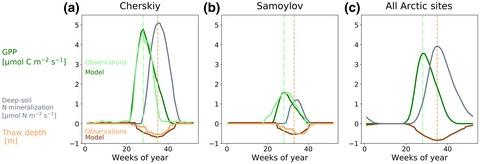当前位置:
X-MOL 学术
›
Glob. Change Biol.
›
论文详情
Our official English website, www.x-mol.net, welcomes your
feedback! (Note: you will need to create a separate account there.)
Mismatch of N release from the permafrost and vegetative uptake opens pathways of increasing nitrous oxide emissions in the high Arctic
Global Change Biology ( IF 10.8 ) Pub Date : 2022-07-19 , DOI: 10.1111/gcb.16345 Fabrice Lacroix 1, 2, 3 , Sönke Zaehle 1 , Silvia Caldararu 1 , Jörg Schaller 4 , Peter Stimmler 4 , David Holl 5 , Lars Kutzbach 5 , Mathias Göckede 1
Global Change Biology ( IF 10.8 ) Pub Date : 2022-07-19 , DOI: 10.1111/gcb.16345 Fabrice Lacroix 1, 2, 3 , Sönke Zaehle 1 , Silvia Caldararu 1 , Jörg Schaller 4 , Peter Stimmler 4 , David Holl 5 , Lars Kutzbach 5 , Mathias Göckede 1
Affiliation

|
Biogeochemical cycling in permafrost-affected ecosystems remains associated with large uncertainties, which could impact the Earth's greenhouse gas budget and future climate policies. In particular, increased nutrient availability following permafrost thaw could perturb the greenhouse gas exchange in these systems, an effect largely unexplored until now. Here, we enhance the terrestrial ecosystem model QUINCY (QUantifying Interactions between terrestrial Nutrient CYcles and the climate system), which simulates fully coupled carbon (C), nitrogen (N) and phosphorus (P) cycles in vegetation and soil, with processes relevant in high latitudes (e.g., soil freezing and snow dynamics). In combination with site-level and satellite-based observations, we use the model to investigate impacts of increased nutrient availability from permafrost thawing in comparison to other climate-induced effects and CO2 fertilization over 1960 to 2018 across the high Arctic. Our simulations show that enhanced availability of nutrients following permafrost thaw account for less than 15% of the total Gross primary productivity increase over the time period, despite simulated N limitation over the high Arctic scale. As an explanation for this weak fertilization effect, observational and model data indicate a mismatch between the timing of peak vegetative growth (week 26–27 of the year, corresponding to the beginning of July) and peak thaw depth (week 32–35, mid-to-late August), resulting in incomplete plant use of nutrients near the permafrost table. The resulting increasing N availability approaching the permafrost table enhances N loss pathways, which leads to rising nitrous oxide (N2O) emissions in our model. Site-level emission trends of 2 mg N m−2 year−1 on average over the historical time period could therefore predict an emerging increasing source of N2O emissions following future permafrost thaw in the high Arctic.
中文翻译:

永冻土释放的氮与植物吸收的不匹配打开了北极高海拔地区一氧化二氮排放增加的途径
受永久冻土影响的生态系统中的生物地球化学循环仍然存在很大的不确定性,这可能会影响地球的温室气体预算和未来的气候政策。特别是,永久冻土融化后增加的养分可用性可能会扰乱这些系统中的温室气体交换,这种影响在很大程度上尚未得到探索。在这里,我们增强了陆地生态系统模型 QUINCY(陆地营养循环与气候系统之间的量化相互作用),该模型模拟植被和土壤中的完全耦合的碳 (C)、氮 (N) 和磷 (P) 循环,以及相关过程高纬度地区(例如,土壤冻结和雪动态)。结合现场级和卫星观测,1960 年至 2018 年在北极高地进行了2 次施肥。我们的模拟表明,尽管在北极高海拔范围内模拟了氮限制,但多年冻土融化后营养物质的可用性增加占总初级生产力增加的不到 15%。作为这种微弱施肥效应的解释,观测数据和模型数据表明植物生长高峰时间(一年中的第 26-27 周,对应于 7 月初)和解冻高峰深度(第 32-35 周,中期)之间的不匹配- 至 8 月下旬),导致永久冻土表附近的植物对养分的利用不完全。由此产生的接近永久冻土表的氮可用性增加增强了氮损失途径,从而导致一氧化二氮(N 2O) 我们模型中的排放。因此,在历史时间段内平均2 mg N m -2 year -1的场地排放趋势可以预测未来北极高地永久冻土融化后 N 2 O 排放源的增加。
更新日期:2022-07-19
中文翻译:

永冻土释放的氮与植物吸收的不匹配打开了北极高海拔地区一氧化二氮排放增加的途径
受永久冻土影响的生态系统中的生物地球化学循环仍然存在很大的不确定性,这可能会影响地球的温室气体预算和未来的气候政策。特别是,永久冻土融化后增加的养分可用性可能会扰乱这些系统中的温室气体交换,这种影响在很大程度上尚未得到探索。在这里,我们增强了陆地生态系统模型 QUINCY(陆地营养循环与气候系统之间的量化相互作用),该模型模拟植被和土壤中的完全耦合的碳 (C)、氮 (N) 和磷 (P) 循环,以及相关过程高纬度地区(例如,土壤冻结和雪动态)。结合现场级和卫星观测,1960 年至 2018 年在北极高地进行了2 次施肥。我们的模拟表明,尽管在北极高海拔范围内模拟了氮限制,但多年冻土融化后营养物质的可用性增加占总初级生产力增加的不到 15%。作为这种微弱施肥效应的解释,观测数据和模型数据表明植物生长高峰时间(一年中的第 26-27 周,对应于 7 月初)和解冻高峰深度(第 32-35 周,中期)之间的不匹配- 至 8 月下旬),导致永久冻土表附近的植物对养分的利用不完全。由此产生的接近永久冻土表的氮可用性增加增强了氮损失途径,从而导致一氧化二氮(N 2O) 我们模型中的排放。因此,在历史时间段内平均2 mg N m -2 year -1的场地排放趋势可以预测未来北极高地永久冻土融化后 N 2 O 排放源的增加。











































 京公网安备 11010802027423号
京公网安备 11010802027423号